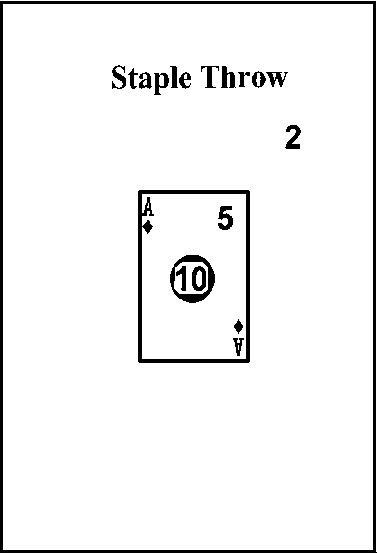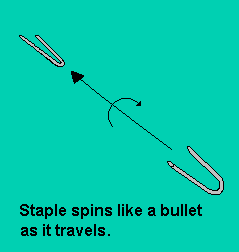
As a youngster, I saw a man throwing all manner of sharp things and sticking them up in a plank of wood - axes, hatchets, knives ,staples etc. His name was John Kneedy, the father of our scoutmaster. It left a lasting impression on me; but it wasn't until recently, that I decided, while on a trip back to my old homeland, to visit with my old scoutmaster, Larry Kneedy, and find out if I was remembering correctly, his late fathers demonstration. He assured me of the affirmitive and gave me some throwing instruction.
I decided to learn staple throwing since they are cheap. Staples, by the way, are those "U" shaped nails that are used to attach wire fences to wooden posts. The best kind are the big ones, 1 3/4" 9 gauge. I get mine at the local hardware store for 88 cents a pound. Other sizes can also be thrown but the big ones have more heft to throw at the target.
If you have ever tried knife throwing, you know how difficult it is to spin them just the right amount so that the tip arrives first at the target. Staple throwing has the same kind of impressive charisma but can be done reliably at any distance, if you know the trick. I didn't know how easy it is, and so I spent several months learning how to do it. Since then, I have found that a good percent of normally dexterous people, who have been shown, can do it in a day - or even minutes.
Staples can be thrown underhand, sidehand, overhand or from just about any position. The trick is to give them a good spin; not a spin like a knife, but a spin like a bullet. The axis of rotation is the line between you and the target. This creates a gyroscopic action that keeps the staple in a stable position facing foreward. If it is thrown with the sharp tips facing foreward, they will stay that way all the way to the target. The pictures illustrate some of the ways of holding, throwing and trajectory of the staple.

A good way of holding the staple for throwing (below). Although this holding position is awkward for spinning of the staple with the fingers, a good spin can be generated by giving the hand a side swipe motion just as the staple leaves the fingers. This position is very good for getting a high throwing velocity and works well with overhand, side and underhand throws.
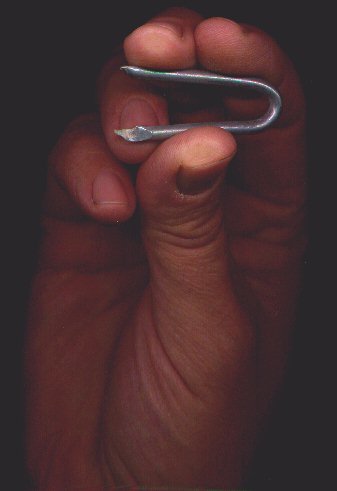
An alternate way of holding (below). This position is good for throwing with the arm out at the side. This position can give a good spin just from flipping the fingers. The side throw seems to give the lowest velocity, but gives a good reliable straight spin and accurate throw.
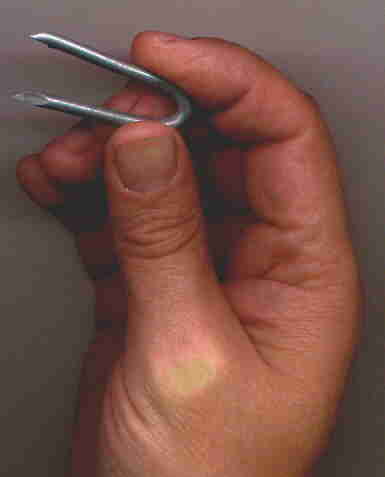
A good materials to practice throwing at include: A large cardboard box folded flat, a large ceiling tile, hi density foam plastic or some foam rubber covered with about 5 layers of newspaper.
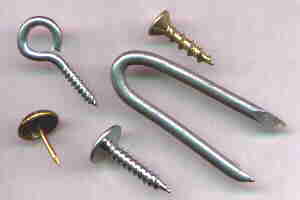
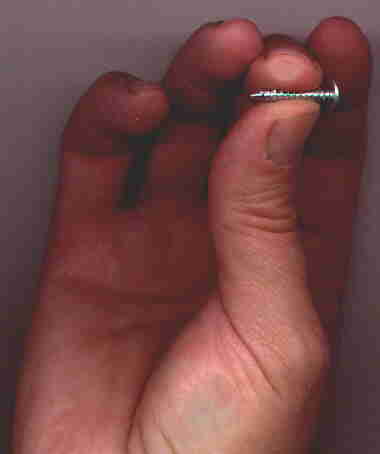
Each contestant throws 15 staples to warm up. Each contestant then throws a second set of 15 staples and a score is recorded. Each contestant then throws a third set of 15 and the score is again recorded. Each contestant then adds the two together and divides by 2 to get an average. The one with the highest score wins.
